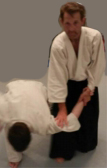Etiquette
Proper observance of etiquette is as much a part of your training as is learning techniques. Standards of etiquette may vary somewhat from one dojo or organization to another, but the following guidelines are nearly universal. Please take matters of etiquette seriously.
- When entering or leaving the dojo, it is proper to bow in the direction of O-sensei's picture, the kamiza, or the front of the dojo. You should also perform a seated bow when entering or leaving the mat.
- Shoes are not allowed on the mat.
- Be on time for class. Students should line up and seat in seiza approximately 3-5 minutes before the official start of class. If you happen to arrive late, sit quietly in seiza on the edge of the mat until the instructor grants permission to join practice.
- If you need to leave the mat or dojo for any reason during class, notify the instructor.
- Avoid sitting on the mat with your back to the picture of O-sensei. Also, do not lean against the walls or sit with your legs stretched out.
- Remove watches, rings and other jewelry before practice as they may cause injury to oneself or one's partner.
- Do not bring food, gum, or beverages onto the mat.
- Please keep your fingernails and toenails clean and cut short.
- Please keep talking during class to a minimum.
- If you are having trouble with a technique, do not shout across the room to the instructor for help. First, try to figure the technique out by watching others. If you still have trouble, ask the instructor for help.
- Do not engage in rough-housing or needless contests of strength during class.
- Keep your training uniform clean, in good shape, and free of offensive odors.
- Please pay your membership dues promptly. If membership dues might stand on the way of you practicing Aikido, please talk with the club president or our chief instructor Weiner sensei.
- Remember that you are in class to learn, and not to gratify your ego. An attitude of receptivity is therefore required.
- It is usually considered polite to bow upon receiving assistance or correction from the instructor.
It is common for people to ask about the practice of bowing in Aikido. In particular, many people are concerned that bowing may have some religious significance. It does not. In Japanese culture, it is a way of greeting someone and also of showing sincerity. Incorporating this particular aspect of Japanese culture into our Aikido practice serves several purposes:
- It creates a familiarity with an important aspect of Japanese culture, which is universal to all Aikido practitioners. Also, learning about another culture can broaden one's cultural horizons.
- Bowing may be an expression of respect. As such, it indicates an open-minded attitude and a willingness to learn from one's teachers and fellow students.
- Bowing to a partner may serve to remind you that your partner is a person - not a practice dummy. Always train within the limits of your partner's abilities.
- While training is in session, you should behave in a certain manner. You should always remember that Aikido is a martial art and as such, deserves your full attention. Bowing is a means of acknowledging the importance of the training you are engaged in.
- When bowing either to the instructor at the beginning of practice or to one's partner at the beginning of a technique it is considered proper to say "onegai shimasu" (lit. "I request a favor") and when bowing either to the instructor at the end of class or to one's partner at the end of a technique it is considered proper to say "domo arigato gozaimashita" ("thank you")

